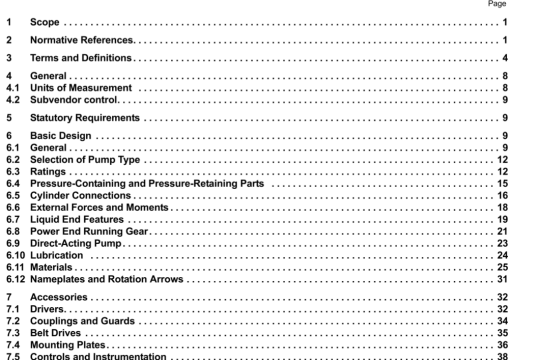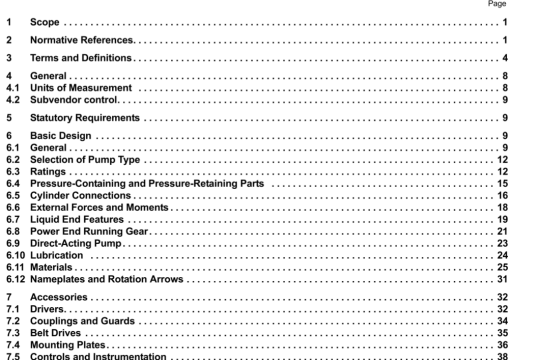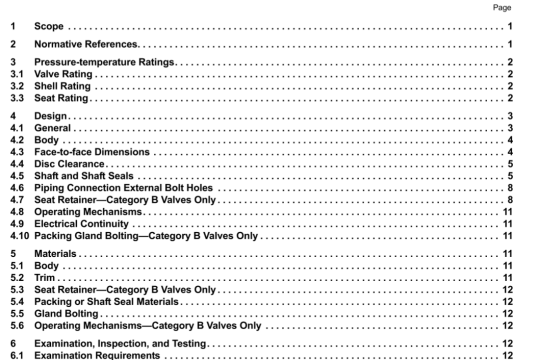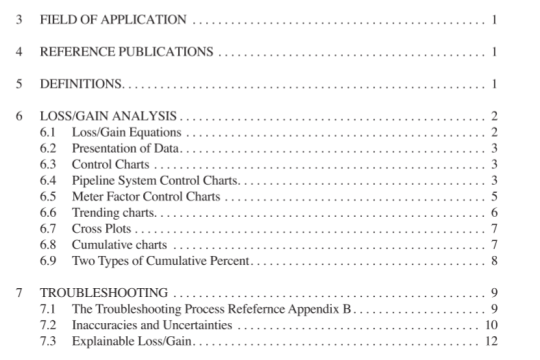API St 594:2010 pdf download
API St 594:2010 pdf download.Check Valves: Flanged,Lug, Wafer,and Butt-welding.
4 Pressure-temperature Ratings
4.1 Valve Rating
4.1.1 The pressure-temperature rating of the valve for various body materials shall be as follows:
— Type ‘A’ valves only:
a) gray iron: the pressure-temperature rating for the applicable flange class as specified in ASME B16.1;
b) ductile iron: the pressure-temperature rating for the applicable flange class as specified in ASME B16.42.
— Type ‘A’ and Type ‘B’ valves:
a)steel, nickel alloy, and other alloy: The pressure-temperature rating shall be in accordance with Standard Class ratings of ASME Bi 6.34, Table 2, for the applicable Group 1, 2, or 3 material of ASME Bi 6.34, Table 1.
b)special materials: The pressure-temperature rating for materials not covered by ASME B16.34 shall be determined by the procedures in ASME B16.34, Appendix B.
4.2 Temperature Restrictions
4.2.1 Restrictions of temperature and concurrent pressure, or pressure and concurrent temperature, (e.g. those imposed by special soft seals or special trim materials), shall be marked on the valve identification plate (see Section 8).
4.2.2 The temperature for a corresponding pressure rating is the maximum temperature of the pressure-containing shell of the valve. In general, this temperature is the same as that of the contained fluid. The use of a pressure rating corresponding to a temperature other than that of the contained fluid is the responsibility of the user.
4.2.3 For temperatures below the lowest temperature listed in the pressure/temperature tables the service pressure shall be no greater than the pressure for the lowest listed temperature. The use of valves at lower temperatures is the responsibility of the user. Consideration should be given to the loss of ductility and impact strength of many materials at low temperature.
5 Design
5.1 Body and Cover
5.1.1 The minimum body wall thickness for various materials shall be as follows:
— Type ‘A’ valves only:
a)gray iron: as shown in Tables 1 and 2 for Class 125 and Class 250 only;
b)ductile iron: as shown in Tables 1 and 2 for Class 150 and Class 300 only.
— Type ‘A’ and Type ‘B’ valves:
a)steel and chrome-moly steels per ASME B16.34, Table 1, Group 1: as shown in Table 1 and Table 2, for Classes 150, 300, 600, 900, 1500, and 2500;
5.1.3.1 Welding a flange to a valve body shall be by full penetration butt-welding. The welding procedure and the welder or welding operator shall be qualified in accordance with ASME-BPVC, Section IX. Valves having flanges attached by welding shall meet the requirements of paragraph 2.1.6 of ASME B16.34.
5.1.3.2 Integral or other alignment rings (centering backing rings) used to facilitate welding shall be completely removed after the weld is completed.
5.1.4 Type ‘A’ valves larger than DN 600 (NPS 24) in Classes 150, 300, and 600 shall have body-flange bolt patterns suitable for the lug or double-flanged type, outside diameters suitable for the wafer type, and gasket surface dimensions compatible with the flange standards specified in the purchase order.
5.1.5 Flange faces with ring-joint grooves shall conform to the dimensions shown in either ASME B16.5 or ASME B 16.47, as applicable.
5.1.6 Flange facing finishes shall be:
— Type ‘A’ valves only: gray iron and ductile iron valves shall be finished as specified in MSS SP-6;
— Type ‘A’ and Type ‘B’ valves: steel, nickel-alloy, and other alloy valves shall be finished as specified in ASME
B16.5.
5.1.7 Auxiliary connections are required only when specified by the purchaser:
— Type ‘A’ valves only: For gray iron and ductile iron valves the size, type, and location of auxiliary connections shall be the manufacturer’s standard unless otherwise agreed by the manufacturer and the purchaser.
— Type ‘A’ and Type ‘B’ valves: For steel, nickel alloy and other alloy valves auxiliary connections shall comply with the requirements of ASME B16.34, Section 6.3. The location and designation of auxiliary connections shall be manufacturer’s standard for Type ‘A’ valves and per ASME Bi 6.34, Figure 1(b) for Type ‘B’ valves.
5.1.8 The valve may have either an integral or a removable seat ring. Sealing compounds or greases shall not be used when assembling seat rings; however, a light lubricant having a viscosity no greater than kerosene may be used to prevent galling of mating threaded surfaces.
5.1.9 Tapped test openings are permitted only if specified in the purchase order. If a tap is made in the body for testing the valve, the tap shall not be larger than DN 15 (NPS 1/2). After testing, the tapped hole shall be fitted with an ASME B16. 11 or ASM E Bi 6.14 threaded solid round or hex-head plug. The test tap may require a boss to provide the minimum thread engagement, as specified in ASME B16.34.
5.1.10 For Type ‘A’ valves a tapped blind hole shall be provided in the body of valves which are either NPS 10 or larger, or which weigh more than 50 lb (23 kg), for attachment of an eye bolt or equivalent lifting device. The hole shall be tapped with a coarse (UNC) Class 2B thread, conforming to ASME Bi .1. If an eyebolt is specified in the purchase order, it shall conform to ASME B18.15.
5.1 .11 Unless otherwise specified in the purchase order, for Type ‘A’ valves the lugs of lug type valves and flanges of double-flanged type valves shall be provided with non-threaded (drilled) bolt clearance holes.
5.1.12 Butt-welding ends shall conform to the requirements of ASME B16.25 for the bore specified for use without backing rings.
5.1.13 Conversion of a flanged end to a butt-welding end is not permitted except by agreement between the purchaser and manufacturer.




